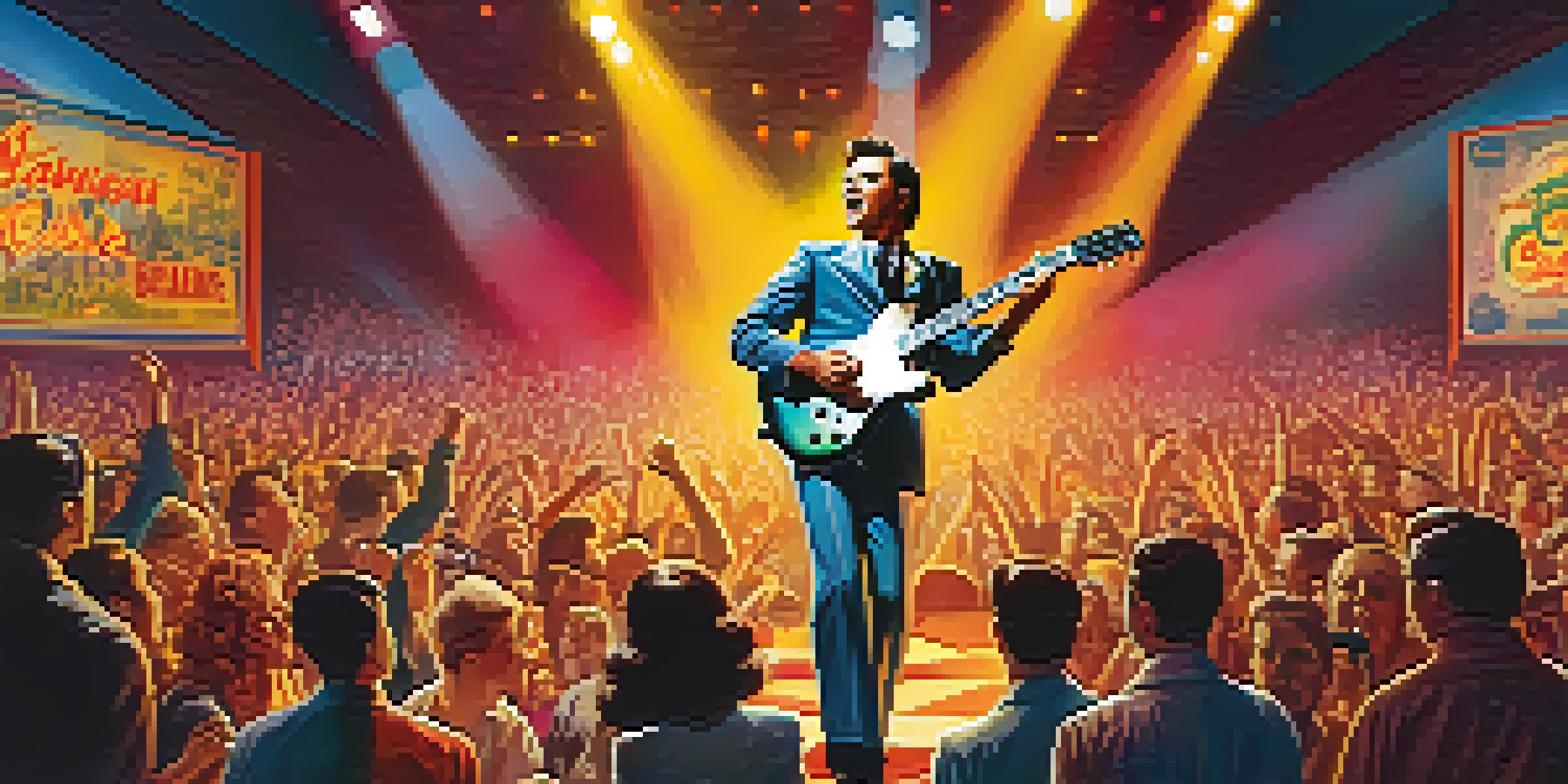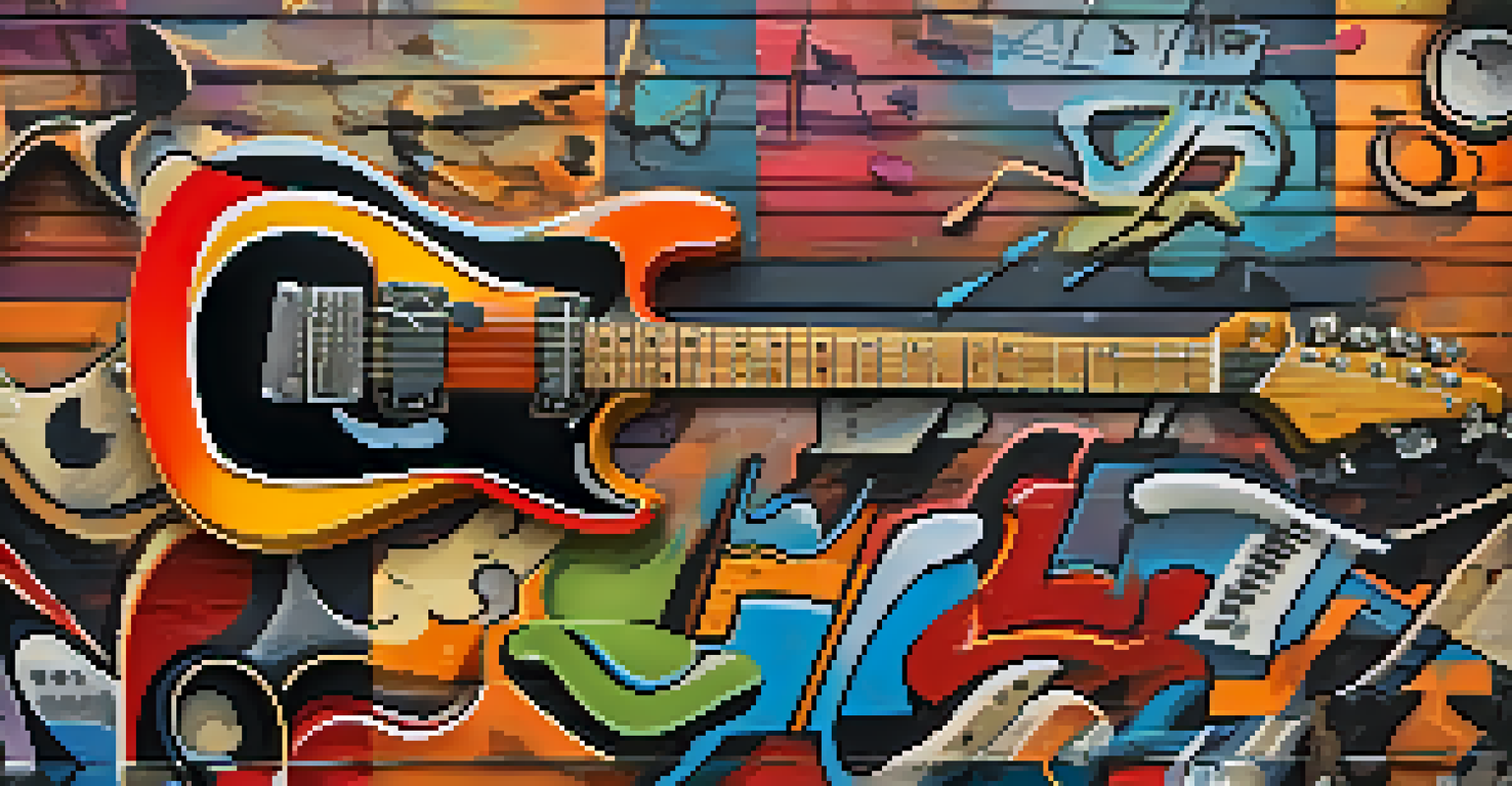Rock and Roll: The Guitar's Role in Cultural Revolution

The Birth of Rock and Roll: A Musical Revolution
Rock and roll emerged in the 1950s, blending various musical styles such as blues, jazz, and country. This fusion created a sound that appealed to the youth of the time, offering a refreshing break from the traditional norms of music. It wasn't just a new genre; it was a powerful cultural shift that gave voice to a generation longing for change.
Rock and roll is a music genre that was born in the United States in the late 1940s and early 1950s, and is often seen as a combination of rhythm and blues, country music, and pop.
At the heart of this movement was the electric guitar, a symbol of rebellion and freedom. Artists like Chuck Berry and Elvis Presley showcased its potential, captivating audiences with electrifying performances. The guitar became more than an instrument; it was a tool for expressing individuality and challenging societal norms.
As rock and roll gained popularity, it also sparked conversations about race, class, and identity. The music brought together diverse cultures, breaking down barriers and fostering a sense of unity among fans. This was just the beginning of the guitar's influential role in shaping cultural landscapes.
The Electric Guitar: A Symbol of Rebellion
The electric guitar quickly became synonymous with the rebellious spirit of rock and roll. Its powerful sound and ability to produce feedback resonated with the desire for change among young people. Icons like Jimi Hendrix and Keith Richards pushed the boundaries of guitar playing, turning the instrument into a powerful voice for social commentary.

Hendrix, in particular, showcased the guitar as a medium for artistic expression, blending genres and creating a unique sound that still influences musicians today. His performances were not just concerts; they were experiences that challenged the status quo, encouraging others to think differently and embrace their individuality.
Rock and Roll: A Cultural Shift
Rock and roll emerged in the 1950s as a fusion of musical styles, symbolizing a powerful cultural movement that resonated with the youth.
As rock music evolved, so did the electric guitar's role. It became a staple in various subgenres, from punk rock to heavy metal, each adding new layers of meaning and rebellion. The guitar's ability to adapt and evolve reflects the ever-changing landscape of culture, always staying relevant to the youth.
Cultural Impact: Music and Social Change
Rock and roll was not just about the music; it was a catalyst for social change during the 1960s and 70s. The genre became intertwined with movements advocating for civil rights, peace, and freedom. Artists used their platforms to address pressing issues, challenging listeners to engage with the world around them.
The electric guitar is the instrument that has shaped the sound of modern music more than any other.
Songs like Bob Dylan’s 'The Times They Are a-Changin'' encapsulated the spirit of the era, urging society to recognize and address injustices. The electric guitar played a pivotal role in these anthems, amplifying messages that resonated deeply with audiences seeking change.
This cultural impact extended beyond music into fashion, language, and lifestyle. The guitar became a symbol of youth culture, representing a break from convention and an embrace of new ideas. The connection between rock and roll, the guitar, and social movements highlights the profound influence of music on societal evolution.
The Guitar in Rock Subcultures: A Diverse Expression
As rock and roll diversified into various subcultures, the guitar maintained its central role in expressing distinct identities. From punk to grunge, each genre showcased different aspects of rebellion and artistic expression. For example, punk rock stripped down musical complexity, emphasizing raw energy and anti-establishment sentiments.
Bands like The Ramones and The Sex Pistols used simple guitar riffs to create powerful statements against societal norms, embodying the spirit of rebellion. Meanwhile, the grunge movement brought a more introspective approach, with guitarists like Kurt Cobain using their music to explore themes of disillusionment and personal struggle.
Electric Guitar: A Rebel's Voice
The electric guitar became an emblem of rebellion and self-expression, driving social commentary and empowering generations of musicians.
These subcultures illustrate how the guitar has continually adapted to express the evolving sentiments of each generation. The diversity of styles and sounds reflects the changing landscape of culture, with the electric guitar serving as a bridge between various movements and ideologies.
Women in Rock: Redefining the Guitar's Role
While rock and roll has often been male-dominated, women have played a crucial role in redefining the guitar's significance within the genre. Artists like Joan Jett and Stevie Nicks broke barriers, proving that women could not only play guitar but also lead bands and write impactful songs. Their contributions challenged stereotypes and inspired future generations of female musicians.
The emergence of female guitarists brought new perspectives to rock music, infusing it with themes of empowerment and resilience. Jett’s anthem 'I Love Rock 'n' Roll' became a rallying cry for women asserting their place in the industry, demonstrating that the guitar could be a tool for empowerment.
As the landscape of rock continues to evolve, the presence of women in the genre remains vital. Their stories and music inspire young girls everywhere to pick up the guitar and express themselves, ensuring that the instrument remains a symbol of freedom and creativity for all.
The Guitar's Legacy: Influencing Modern Music
Today, the legacy of rock and roll and the electric guitar can be seen across various music genres, from pop to hip-hop. Artists like Billie Eilish and Lil Nas X incorporate guitar elements into their music, demonstrating the instrument's versatility and enduring appeal. This cross-genre blending showcases the guitar's ability to adapt to contemporary sounds while retaining its iconic status.
Moreover, the influence of rock guitarists continues to inspire new generations of musicians. Many aspiring artists cite legends like Eric Clapton and Slash as key influences in their musical journeys. The guitar remains an integral part of music education, encouraging creativity and self-expression among young musicians.
Women Redefining Rock's Legacy
Female artists have played a crucial role in redefining rock music, showcasing the guitar as a tool for empowerment and challenging industry norms.
As we look to the future, the electric guitar's role in shaping music and culture is far from over. Its legacy as a tool for rebellion, expression, and connection ensures that it will continue to resonate with audiences around the world.
Conclusion: The Guitar's Enduring Cultural Significance
In conclusion, the electric guitar has played a pivotal role in the rock and roll movement, influencing not only music but also cultural attitudes and societal change. Its ability to adapt and resonate with different generations highlights its significance as a symbol of rebellion and creativity. From its inception to modern-day music, the guitar has been a powerful force for expression.
The stories of the artists who wield the guitar reflect broader cultural narratives, showcasing the intersection of music, identity, and social change. As rock continues to evolve, the guitar remains a vital instrument for those seeking to challenge norms and express their individuality.

Ultimately, the electric guitar is more than just an instrument; it embodies the spirit of rock and roll and serves as a reminder of the power of music to inspire and transform society. As we celebrate its legacy, we look forward to the new sounds and movements it will inspire in the future.